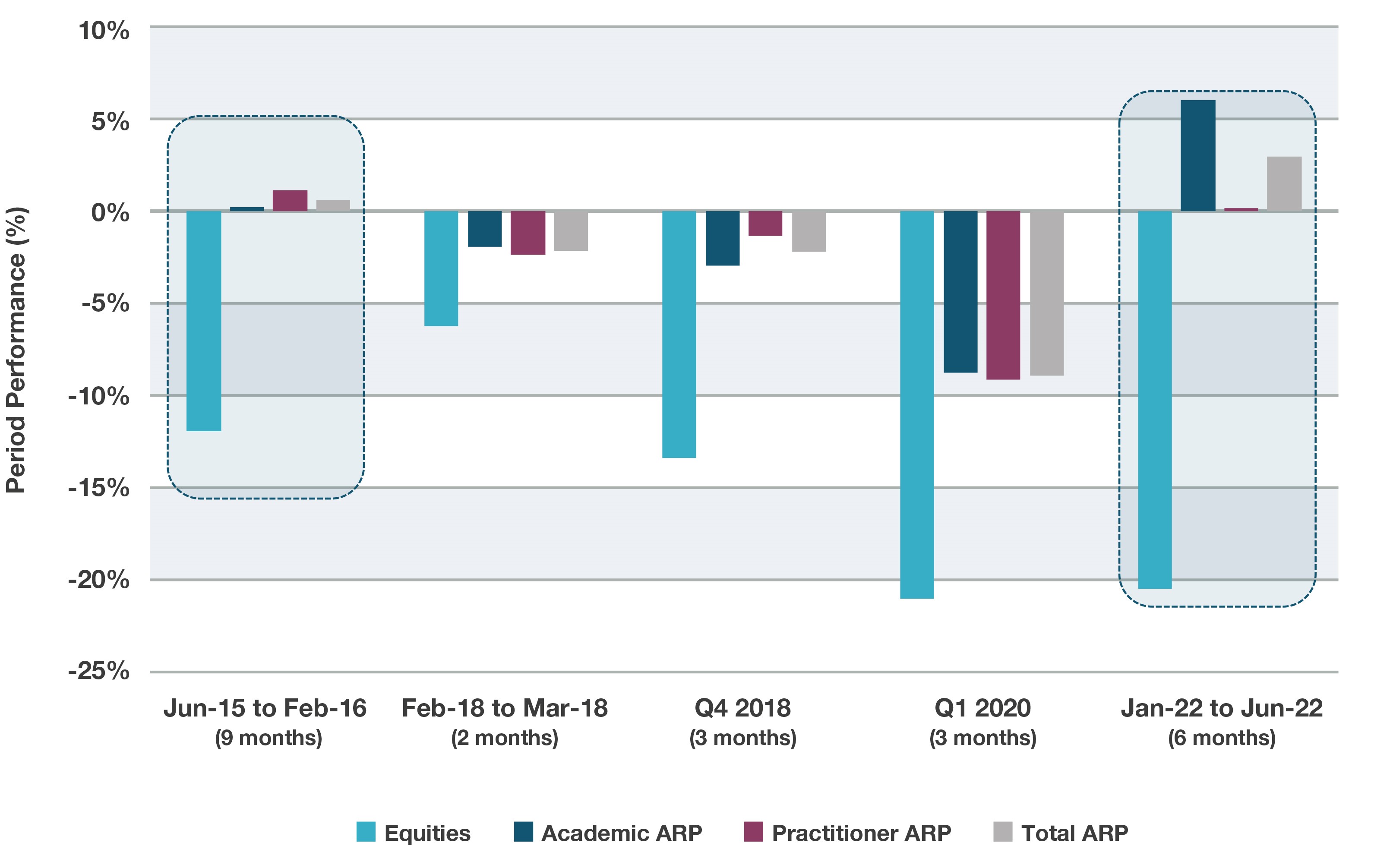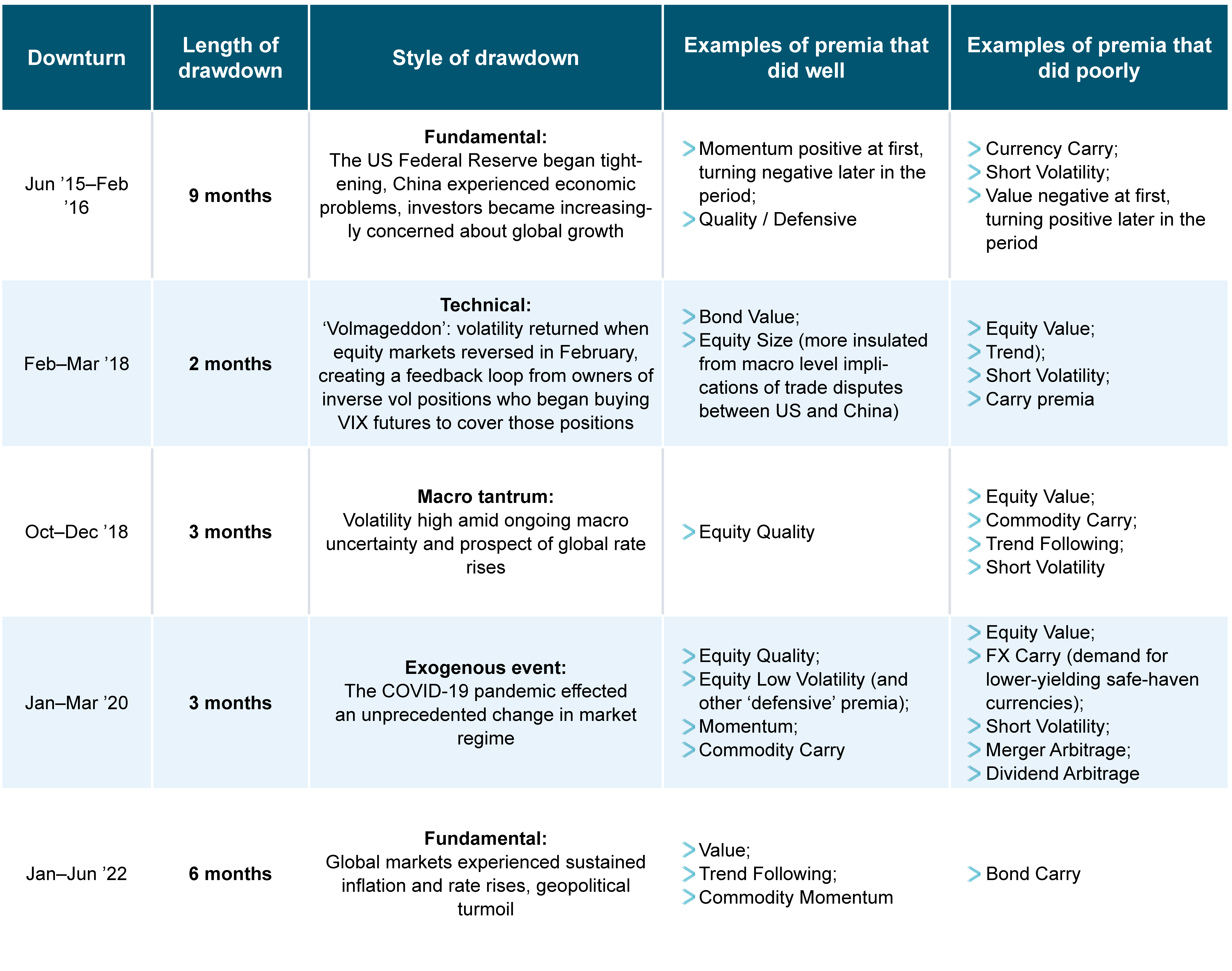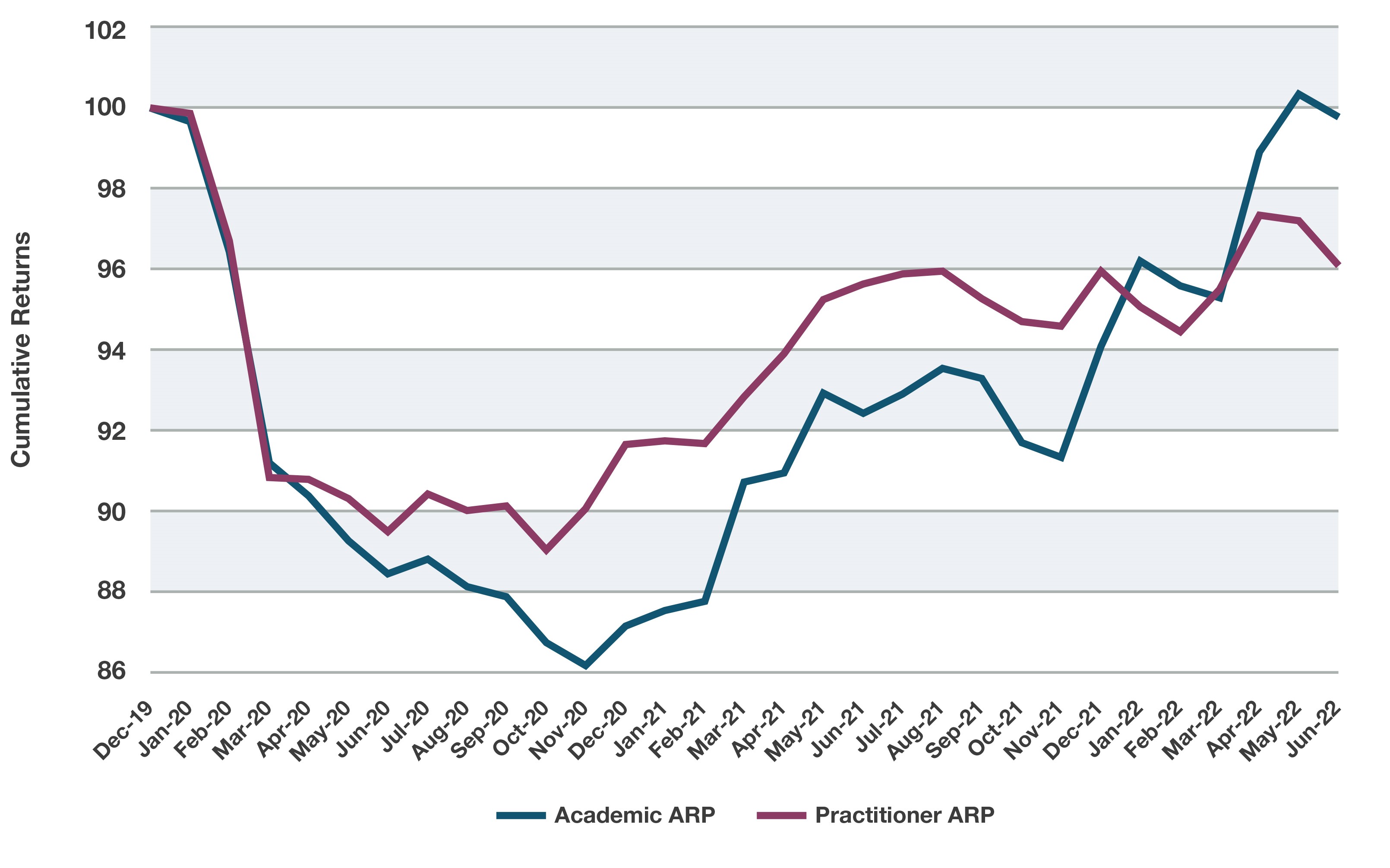bfinance insight from:

Pravir Sharma
Senior Associate

Toby Goodworth
Director, Public Markets
The first half of 2022 saw Alternative Risk Premia (ARP) strategies deliver—at last— meaningful positive returns during an equity market downturn. This result is of major significance for a group of strategies that have often been criticised for their performance during bear markets. What does this mean for the future of ARP strategies? And why do so-called ‘fundamental’ market downturns favour ARP while ‘technical’ ones may not?
ARP strategies suffered a major fall from grace in 2020, with large losses building on a not-terribly-flattering performance picture in 2018–’19. (We discussed the rout in a bfinance article earlier this year.) Although performance has (mostly) recovered since the lows of mid-2020, as shown in Figure 3, the popularity of ARP has not. Fund closures have continued, with 29% of all ARP strategies open in January 2020 no longer available today. An additional 10% have pivoted away from the ARP space, morphing into (more alpha-focused) systematic macro or quantitative multi-strategy hedge funds as managers have reframed and rebranded their products.
One key contributor to negative investor sentiment has been the sector’s unconvincing performance specifically at times when equity markets have done poorly. ARP strategies have outperformed equities during the five significant (>5%) drawdowns that the MSCI World has endured since 2012, but delivered positive absolute performance (on average) in just two of them, as highlighted in Figure 1. Although the young nature of the strategy may make performance judgements somewhat unfair, they must still (inevitably) be made.
Figure 1: Performance of ARP strategies during equity market downturns since 2012

Source: bfinance, MSCI, Bloomberg. ‘Equities’ indicates MSCI World (USD) index. The bfinance ARP composite is an equally weighted composite of all ARP strategies whose performance is tracked by the firm. ‘Academic ARP’ strategies use well-established academically-validated risk premia (e.g. Value) while ‘Practitioner’ strategies also include systematised versions of some popular hedge fund trading strategies; read more in this paper.
These losses, even when they are very modest compared with markets, can be problematic optically for any strategy whose primary purposes are diversification and absolute return generation. Yet they are also problematic mathematically. ARP strategies aim to eke out gradual, moderate, relatively steady returns with diversified exposure to non-traditional drivers of return, rather than shooting the lights out in good times. Consequently, even modest losses can take many months—or even years—to fix.
In this context, the strong results of 2022 deserve close attention. What makes this downturn different from those in 2018 and 2020? Why was ARP positioned to deliver better protection in 2015-’16 and again in 2022? And what is the significance of these differences for investors thinking about whether and how to allocate to ARP going forwards? Figure 2 highlights some key differences between these drawdowns and risk premia performance.
Figure 2: Market downturns and performance of risk premia

Source: bfinance. It can be challenging to draw simplistic conclusions on which premia did well/poorly, given the different ways of defining and constructing these premia (and the resulting performance differences). This table provides an approximate indication for narrative purposes.
The first takeaway from this analysis appears to be that ARP strategies have fared better in long sustained drawdowns than in shorter, sharper market reversals. The second (somewhat related) conclusion is that they have benefited from ‘fundamental’ downturns and struggled during those that were driven by technical or exogenous factors.
One could view this analysis as being relatively favourable to ARP. Long, sustained equity market drawdowns are likely to be more damaging to investors than briefer shocks from which markets recover more rapidly. Diversifying strategies that deliver positive returns during the former are, arguably, more desirable in a wider portfolio context.
A widening gulf between ‘winners’ and ‘losers’
The performance gap between the ‘winners’ and ‘losers’ in the ARP world—based on their results since the low-point of 2020—widened further in the first half of 2022. If we look at the cohort that have recovered from their 2020 losses (38% of the surviving, non-rebranded strategies have now returned at least to January 2020 levels), these have now generated an average return of 21% since October 2020. On the other side, those that have not regained their January 2020 levels have delivered an average return of 4.9% in that period—and more than half of them still have double-digit deficits versus January 2020. This data (all net of fees) suggests that further fund closures are likely to occur.
The widening gap is particularly interesting when we consider the shift in market conditions since late-2021. The changing environment has led to a much stronger period of performance for what we term ‘Academic’ ARP strategies versus ‘Practitioner’ strategies, as shown in Figure 3.
Figure 3: Cumulative return of bfinance ARP composite, December 2019 onwards (Academic versys Practitioner strategies)

Source: bfinance
‘Academic’ ARP strategies, which rely on classic, academically established risk factors (as discussed here), experienced more severe losses in 2020 than ‘Practitioner’ strategies, which incorporate systematised versions of hedge fund trading strategies. The first twelve months of recovery saw these two groups moving broadly in tandem. Yet ‘Practitioner’ strategy performance subsequently stagnated during the first half of 2022 while ‘Academic’ strategies soared, driven by the exceptionally impressive performance of trend-following premia and equity value factors—both of which are more prominent in the Academic group.
Rebuilding investor confidence
As a strategy, ARP still has a great deal of work to do if it is to regain the positive investor sentiment that saw AuM soar in 2014–’17. Yet strong performance during the protracted bear market of 2022 provides an important (and much-needed) demonstration of the sector’s ability to deliver good returns in periods of difficulty. Although further consolidation and fund closures can be expected, the foundations are now in place for stronger demand going forwards.
Important Notices
This commentary is for institutional investors classified as Professional Clients as per FCA handbook rules COBS 3.5R. It does not constitute investment research, a financial promotion or a recommendation of any instrument, strategy or provider. The accuracy of information obtained from third parties has not been independently verified. Opinions not guarantees: the findings and opinions expressed herein are the intellectual property of bfinance and are subject to change; they are not intended to convey any guarantees as to the future performance of the investment products, asset classes, or capital markets discussed. The value of investments can go down as well as up.


 English (Global)
English (Global)  Français (France)
Français (France)  Italiano (Italia)
Italiano (Italia)  Dutch (Nederlands)
Dutch (Nederlands)  English (United States)
English (United States)  English (Canada)
English (Canada)  French (Canada)
French (Canada) 

